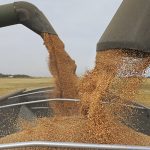Argentina is the world’s leading exporter of processed soybeans as well as a major corn and wheat supplier, but its production has been hurt by drought and other severe weather, causing major losses for farmers and the cash-strapped government.
Tag Archives Wheat

Research identifies fungal toxin threat to wheat
Fusarium has been found across Europe with half the wheat intended for human consumption containing vomitoxin
Researchers examined data from across Europe and the U.K. from the past 10 years and found that fusarium mycotoxins were discovered in every European country with half of the wheat intended for human consumption containing the fusarium mycotoxin DON (often referred to as vomitoxin).
Markets so far shrugging off reports of flooded Chinese wheat fields
China's prime wheat-growing region received a deluge of rain at the end of harvest. Reuters reports that fields of ripe wheat in Henan province were flooded the week ending May 28. That province produced 28 percent of last year's wheat crop.

Analysts see promise in this year’s growing season
North America’s spring wheat crop is late getting in the ground, but production prospects still look promising, say analysts. Farmers in the United States were 64 percent done seeding as of May 21, according to the U.S. Department of Agriculture. That is below the five-year average of 73 percent. Growers in Saskatchewan were 68 percent […] Read more

Ultra-early seeded wheat can survive
Are the risks associated with planting before temperatures can support a crop worth potential benefits?
When early seeding works it means early harvest and reduced odds of frost damage in the fall, hail and other risk factors. If ultra-early seeding works, it can also provide a grade benefit.
Gene family stimulates longer wheat roots
Scientists at the University of California, Davis, have discovered that the right number of copies of a specific group of genes called OPRlll can stimulate longer wheat root growth, offering opportunities for farmers to grow healthier crops with greater yields, despite climate variables.

Ukraine grain exports reduced by ‘difficult logistics’
In an opinion piece published on APK-Inform, Christina Serebryakova, head of analytics at Atria Brokers, said the country is having difficulty competing with other exporters due to "extremely difficult logistics."

Canadian farmers expected to plant most wheat since 2001
Spring wheat plantings, the biggest portion of Canada's all-wheat production, are seen reaching 19.4 million acres, also the most since 2001 and up 7.5 percent from last year, the report showed.

Wheat ignores late-seeding prospect
Minneapolis futures prices continue to slide even as expectations grow that U.S. crop will get off to a late start this spring
U.S. growers indicate they will be planting the smallest spring wheat crop in 50 years at 10.6 million acres. It would be a big deal if that number was slashed even further.
Australia set for 3rd year of bumper wheat harvests, easing world supply woes
SINGAPORE, June 2 (Reuters) – Australia is poised for a third year of near-record wheat production in 2022 as good weather boosts planting across its grain belt, easing concerns over tight global inventories. World wheat supplies have tightened after Russia’s invasion of Ukraine earlier this year cut off shipments from one of the top exporting […] Read more






